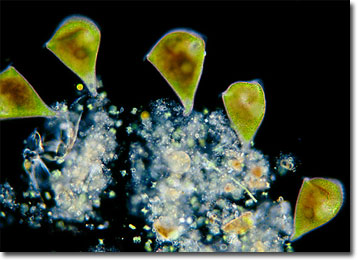Wim van Egmond
Stentors
In the Iliad, an ancient Greek epic about the Trojan War attributed to Homer, Stentor was a herald reputed for his booming voice. This loud messenger was the inspiration for the name of a group of large, trumpet-shaped protozoa common in freshwater ponds.

Stentors are sometimes alternatively referred to as trumpet animalcules due to their commonly observed, sessile shape. However, when these organisms are in motion they transform into a less familiar pear or oval-shaped form, locomoting with the help of numerous hairlike cilia. As soon as a suitable substrate or feeding location is encountered, the individuals settle down and resume their prior appearance. In this form, vibrating cilia lining the rim of the trumpet create water currents that draw food particles into the gullet. Stentors will not, however, eat just anything that passes their way. These discerning protozoa are selective feeders, consuming ciliates in preference to algae and other organisms, and doing so with increasing discrimination as their hunger diminishes.
Reaching lengths of up to 2 millimeters, members of the genus Stentor are some of the largest unicellular organisms in the world. In fact, they are so big that they outsize several multicellular organisms, such as water fleas and rotifers. The relative bulk of stentors seems to require that their physical make-up be slightly different than smaller protozoa. For instance, instead of possessing a typical, round macronucleus, the macronucleus of a stentor is fashioned like a string of beads that runs along the length of its body. This design may play a part in the marvelous ability of stentors to regenerate even when only a tiny fraction of the original individual is left intact. Further studies, however, are needed to determine with certainty the importance of nuclear form.
BACK TO WIM VAN EGMOND GALLERY
